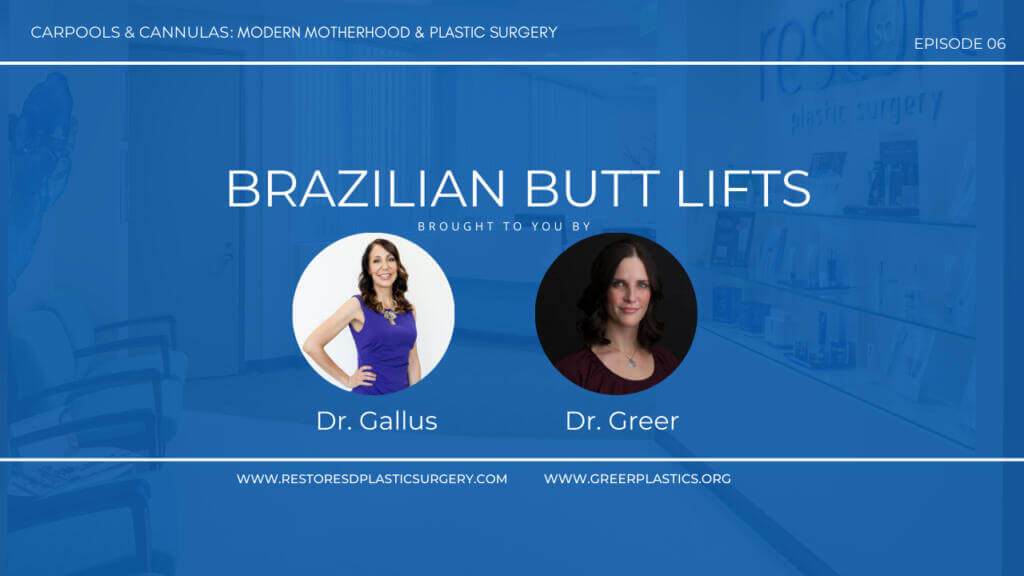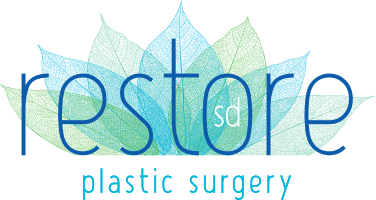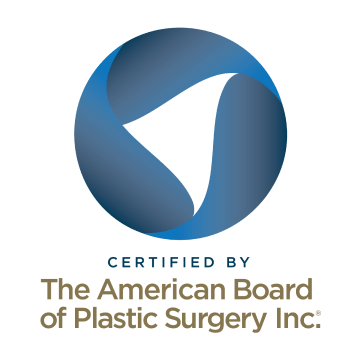About the Episode
On this episode of Carpools & Cannulas: Modern Motherhood and Plastic Surgery, Dr. Gallus and Dr. Greer discuss facts about the Brazilian Butt Lift. Is it for Brazilians? Does a BBL actually lift, or is it a weird name for fat transfer to the buttocks? That and more on our IG Live Episode 6.
Transcript
Dr. Greer: Hey everyone. Happy Wednesday. Dr. Gallus will be joining momentarily, and we’re doing another episode of “Carpools and Cannulas” and tonight we will be talking about BBL, which stands for a couple of things, but namely Brazilian Butt Lift is the version we’re talking about. It can also stand for BroadBand Light, but that’s not what we’re discussing tonight. Oh, hello people who are joining. Welcome. If you wonder, I just got lip filler last Friday. So this is what it looks like. Ow, I see. Dr. Gallus, let me pull her on. Awesome, we’re asking her in. Yeah, so I still have, like, a tiny bit of swelling right here. Lip filler was on Friday, so maximum swelling this weekend. Hey.
Dr. Gallus: Hi. Hey, how’s it going? Your lip filler looks nice.
Dr. Greer: And I see children. It’s fine. Ow, you’ve got people too. How are you?
Dr. Gallus: I’m good. How are you?
Dr. Greer: I’m good. I decided to try the…Hello, child. Can I help you? You’re quiet. Okay. Here, do you wanna come say hi? Come say hi to everybody. Come on the live video. Say hi. This is Wyatt, he turned seven on Sunday. He’s my oldest.
Wyatt: This Sunday I’m turning seven.
Dr. Greer: Yeah, this Sunday he says.
Dr. Gallus: She’s doing homework right next to me. This is Juliana.
Dr. Greer: Juliana. Oh, yeah, I know, I have my headphones in. And I see Ella is up as well. Okay, why don’t you guys go turn on the TV and I’ll let your dad deal with you when he’s out of the shower. I’m not in charge of… Okay, you come say hi too. This is Ella. She’s five. Wyatt, I’m talking. Yeah, bedtime is like…it’s like a suggestion.
Dr. Gallus: Yeah. Quite true. So, yeah, so you got your lip filler done. What product did you use?
Dr. Greer: Yeah. We did RHA 2 because that’s what I had in my sample drawer. Yeah, which I like. I like how it feels. It’s really flexible. But I’m training my nurse practitioner to do injectables. She does laser right now. So, she did my lips. Yeah.
Dr. Gallus: Nice. Yeah, it looks good.
Dr. Greer: So that’s fun.
Dr. Gallus: I know. I need to do mine, and I keep like, “Ow, next week, next week, next week.” And then I…
Dr. Greer: I know, I do that too. I do that too.
Dr. Gallus: And I was to use RHA 3. I was between two and three.
Dr. Greer: Three is nice. I mean, they’re both, it’s just a little more like defined I think with three versus two.
Dr. Gallus: Okay, people are sneaking out of my place.
Dr. Greer: I know, I have a dog under feet, I have kids up. It’s fine. See you guys. We’re the non-glam squad. Although I did feel Dr. Malfie’s headphone microphone trick.
Dr. Gallus: Ow, nice. Yeah, that’s good. I tried to Bluetooth in, then I’ll like click into whoever’s monitoring like it just switches over, and that’s…
Dr. Greer: Yeah. That’s no fun.
Dr. Gallus: …for something and it’s not…
Dr. Greer: It’s not our demographic or really what we’re doing.
Dr. Gallus: Yeah. So, BBL.
Dr. Greer: BBL. BBL. And that’s the Brazilian Butt Lift BBL, not the BroadBand Light BBL.
Dr. Gallus: Right. That’s right. Yeah, so it’s, I think somebody suggested us talking about it last time when we chatted. So it is not necessarily has anything to do with Brazil or Brazilians, and it’s not actually lifting for butts. So it’s really…
Dr. Greer: It’s really a total misnomer. Yeah, what it truly is is fat grafting to the butt. But there’s no lifting. And like you said, no Brazilians. Although was it created in Brazil? I mean.
Dr. Gallus: It might have been.
Dr. Greer: Yeah. I remember hearing that. Where did I hear that, that the country pays for so much of the cosmetic surgery that there are a lot of new techniques that originate there? Might have read that somewhere.
Dr. Gallus: Well, as a medical student I traveled to Chile, and so like in the late ’90s, and we did a BBL there, and they didn’t even call it that. They just did it. They were doing a ton of lipo, and they were like, “Now watch this.” And I was like, “What are you guys doing?”
Dr. Greer: What’s happening?
Dr. Gallus: It wasn’t a thing here. Yeah. So…
Dr. Greer: Yeah. And now it is a big thing in some areas, not so much in the Midwest.
Dr. Gallus: It is pretty popular in Southern California. Sometimes when I’m doing a liposuction case and I am like going the waist, the OR staff will be like, “You’re just gonna throw that away?” Like if I’m not reinjecting.
Dr. Greer: You’re not putting it?
Dr. Gallus: I’m like, “Yeah, that’s kind of…some people don’t want it reinjected.” But it does work pretty well if you want to enhance, like, the upper outer area of your booty, or fix…
Dr. Greer: Like if you have like the hip dip. It’s the hip dips.
Dr. Gallus: Yeah, it’s the hip dips. So, I just saw somebody the other day who was like, “Ow, I didn’t know that that’s what that was called or that it even had a name.” And I was like, “Yeah, no, we have a name for everything now.” So hip dip.
Dr. Greer: It’s an interesting procedure in so many ways, you know, from the professional aspect that patients don’t see. I think one because of, we see so many results where the photographs are on the table and not three months out, which is really, really important. Ow, I see my Allergan rep’s on. Hey, Joel. So when you see photographs after surgery, you want it three to six months down the road. And for fat grafting, that’s especially critical because only like 50% to 80% of the fat takes. So the results you see immediately after surgery are not the actual results.
Dr. Gallus: Right. And also sometimes the results you see on the table are, like, kind of crazy. So many comments.
Dr. Greer: Yes, they’re like huge.
Dr. Gallus: Hip butts. That’s funny. Somebody said, “Yeah, they call them hip butts.”
Dr. Greer: Hip butts. Nice.
Dr. Gallus: Hip dips is better.
Dr. Greer: Thank you, Amy. Yeah, I don’t know, hip butts works too. But yeah, like, you see it is hugely overdone. And if that was the actual result, I just shudder to think what happens when that person gains 20 or 30 or 40 pounds because those fat cells all gain fat.
Dr. Gallus: Right. Right. And so that’s the other… Like I think we’ve talked about this with liposuction, but your fat cells either get bigger or smaller. So moving them just means those fat cells that now if you gain or lose weight, so I’ve had some people who’ve done BBLs and then lost weight, like your butt’s gonna shrink too. There’s not some magic imposed when you graft it that it’s not gonna not shrink with you. And then if you gain weight, so that can be an issue if we’re gonna put…
Dr. Greer: Get bigger.
Dr. Gallus: Yeah, a ton of fat in there or do a lot. And I do think there is a limit to making it proportional, and then obviously, then cartoon character land, which is, you know, sort of Kardashian look.
Dr. Greer: Well, and beyond just the aesthetic, it’s the question of how much of that fats going to survive, because if…So here’s the thing about fat grafting if you don’t know, which I don’t expect you to. The fat has to get blood supply, which means you have to do thin layers of fat with tissue in between so it can get nutrients and blood supply from the surrounding tissue. And if you just pour a bunch of fat in there, it will just die, and you end up with this liquid oil cyst.
Dr. Gallus: Yeah or fat necrosis. So there are limits to how much you can put in. It is a graft, so you need it to survive otherwise, yeah, you’re just creating new problems. And that applies to fat grafting to the breast too. But I feel like people tend not to push the limits, at least on Instagram, with fat transfer to the breasts like they do to the booty. And then the other thing is that that’s a popular procedure to travel for in my anecdotal experience or non-anecdotal experience. So people will travel. So I’ve seen multiple patients that have traveled to Miami, which is a hot spot, to get their BBL done, and then come back with a problem. Or also insanely go travel to Tijuana and then come back with a problem. And it’s just not worth it to go somewhere and then not realize that you’re maybe not gonna meet the surgeon until five minutes before surgery. You’ve already paid upfront. As soon as your case is done, they’re sending you to a hotel room, and then you’re on a plane the next day, and good luck. So…
Dr. Greer: Right. And that’s just one of the problems traveling period. And in Miami too, I think there are a lot of non-plastic surgery trained people who are, you know, they’re cosmetic surgeons, but they’re not board-certified plastic surgeons. So the training is very, very different. And they’re doing… So if it’s really a low price point, you got to ask why.
Dr. Gallus: Right. And there was just a “Union-Tribune,” which is the “San Diego Union-Tribune” article about three women who traveled to Mexico to have surgery because the price point was so low, one of them died, one of them was in the hospital for several weeks, and one of them is still on dialysis. And it, you know, it’s not worth it. And they even interviewed, there are board-certified plastic surgeons in Mexico. Like there is medical training there. But when you go across, you’re certainly not, that’s not who you’re seeing. They might not even be physicians. Those people are operating, you know, outside of their practice of care. It can happen in the States as well depending on the state you’re in. And how are you as a consumer, as a patient supposed to know that? And so that’s one of those…Miami’s also notorious for having multiple deaths related to this procedure. So…
Dr. Greer: Yes, there’s like one particular clinic I always hear about and the name changes, but it’s always the same people running it. And what they do is it’s a doctor overseeing a bunch of PAs, and they’re doing the actual surgery. And here’s the thing about BBL too which most people don’t realize, there is a danger component there that’s not there with other cosmetic surgeries because the gluteal muscles, your buttocks muscles, have really big veins, and it’s very easy if you get too deep. If fat goes into a vein, you get a fat embolism, and that is when the fat actually goes to your lungs, and it can cause major issues and even death.
Dr. Gallus: Right. And that’s where they think those deaths often have been attributed to a fat embolism. And so there was guidance a few years ago about making sure that everybody stayed above the muscle to, and it’s kind of tasks force on safety and analysis of the cases where there had been, you know, horrible complications such as death, and that was the consensus, was to stay above the muscle. Because at the time, they thought if you can graft into the muscle then you can get even more fat in there. And so they were talking, you know, 1000, 1500 ccs in each buttock, which again…
Dr. Greer: It’s a lot.
Dr. Gallus: It’s a lot of, you know, it’s a liter bottle of fat that you’re putting in someone’s, you know, butt cheek, and it’s a lot. So yeah, so you have to be cognizant that your surgeon knows the risks of doing the procedure. And a lot of times, I explain, it’s less about making, you know, more. We have a colleague that practices in Tampa, Dr. Gruber, who calls it “The Gruber Booty,” but, you know, when you liposuction that waist and that little area above where your butt starts, it actually gives the illusion of more of a projecting butt. So it almost is a little bit of a booty lift just to liposuction the waist. And that I think is helpful, and you don’t actually need to put in, you know, 1100 ccs to accomplish anything, because, again, we don’t know long term what that’s gonna look like and how anybody is gonna be able to fix it later.
Dr. Greer: Right. I mean, the best BBLs in my mind have that aggressive lipo of the waist like Dr. Gruber does, she’s a wizard. And she does do some fat injections, but it’s mostly lipo. And then if you’ve got the hip dips and you want that really perfectly round-shaped buttocks, then that’s where just adding some shape, not trying to go for the Kardashian look, not trying to make it super big.
Dr. Gallus: Right. I agree. Yeah, totally.
Dr. Greer: And it’s kind of a tough recovery that first week too, because you can’t sit.
Dr. Gallus: Yeah, so I give my patients, we call it a booty buddy, but it’s a big foam pillow that you sit on but your bottom hangs off of. So your thighs are on the pillow, right? And then that way your butt is not in direct contact with the seat so that you’re not putting pressure on the graft. And you can’t sleep on your back, you need to sleep on your side or your belly. And it is uncomfortable because usually, it requires a significant amount of liposuction. Some of my skinnier patients, I have to scrounge for fat, so they have multiple sore areas. Maybe I, like, harvest it from arms and waist and a little bit on the thighs, and so you’re not even sure like what area to even respond to because you’re just sore everywhere. So…
Dr. Greer: Right, and then you’re laying in awkward, uncomfortable positions on your stomach all the time, which gets pretty old after a couple of hours.
Dr. Gallus: Right. So yeah, making sure that patients understand the recovery time is important for sure. And making sure that the liposuction is being done by someone who’s experienced in getting a good result there too is important. We’ve talked about liposuction before.
Dr. Greer: Yeah. Yeah. And you can end up with some weird contour irregularities. If you go too superficial, you can really scar the skin and it looks damaged and gets hyperpigmented, which is like the pigmentation gets darker. It’s not cool.
Dr. Gallus: Right. Right. And I do tend to use a closed system for a fat transfer. Is that what you use or?
Dr. Greer: You know, I do so few BBLs here, I don’t think I’ve done one in even a couple years that I was gonna switch to the REVOLVE, I think that’s on backorder. But yeah, we did do a closed system last time. But like I said, it’s not one we do a lot here, and I’m okay with that. I’d rather just do the aggressive lipo.
Dr. Gallus: Right. Right. So yeah, so I end up using a closed system. We don’t use REVOLVE. I do use it actually in the hospital setting because they have that, which I’ve done when I’ve combined it with a breast reduction case. But when I’m in cosmetic land, Office ORs, and surgery centers, we tend to use something, some sort of closed system. So a sterile canister, it collects, and then it just decants the fat, and then using that same system, reinject the fat. So it’s not really getting exposed to air. There’s no centrifuging. Like the process of fat transfer has gotten much better in terms of how we’ve learned, what to do, and what works and what doesn’t work. Rinsing fat a bunch of times doesn’t necessarily add anything to it. And some of those stromal stuff that comes along with the fat I think helps kind of enhance that area in general. It helps with, you know, tissue regeneration to some degree. So you don’t want to lose all…
Dr. Greer: Right, because you get some of the stem cells.
Dr. Gallus: Yeah. So you don’t wanna lose all of that right off the bat. So I do use a closed system for that. And you don’t have to, but it just to me, it makes a cleaner process. And then when I’m doing the reinjection, it is under power assist. So it’s lipofilling…
Dr. Greer: Isolating.
Dr. Gallus: Yeah, isolating. So you get a little bit more evenness when you’re doing it. Certainly, you can hand inject, but that’s just not how I’ve been doing it. It’s just that this is a more efficient way.
Dr. Greer: That’s nice. Yeah, I really mostly do fat grafting to the face. So it’s small amounts, and we harvest, there’s something called the Tulip cannula. It’s just like a syringe with a cannula on it. Harvest with that, I do centrifuge it a little bit just to get the supernatant and off, but that’s very small volumes. I mean, we’re talking like 10 or 20 milliliters, not like 600.
Dr. Gallus: Right. And we do that too when we’re doing face as well for sure.
Dr. Greer: Yeah. Yeah. And the goal with all those things we’re doing when we’re talking about washing the fat versus, like, spinning in a centrifuge, the goal is to get the best amount of survival of the fat.
Dr. Gallus: Right. Ow, which brings me to my other point, which is I tend not to Vaser. Like, I don’t use any kind of device that’s gonna heat up the fat when I know I’m gonna graft it. So…
Dr. Greer: Right, because you don’t want to kill those fat cells.
Dr. Gallus: Right. So no energy devices unless I’m done liposuctioning, or I know I’m not gonna use any, you know, I have more liposuction to do but I’m not gonna use that fat for transfer. So that’s another little tidbit that has to be factored in. Which is kind of a bummer sometimes because people, I think, on their lower back sometimes benefit from me Vasering first, it just makes my job easier, I can get a little more aggressive, but that’s the brakes.
Dr. Greer: Yeah, that is some fibrous fat in the lower back.
Dr. Gallus: Mm-hmm. Yeah. Some variants are tougher.
Dr. Greer: What other common questions do we get? A lot of times I feel like BBL is one of those procedures that’s very, patients come in with this really specific goal about how much fat they want because that’s what they’ve seen on Instagram. And it’s not, you know, the best in terms of, like, setting expectations. It’s a little tough because they want this volume so that they look like this patient when really they may have a totally different body type.
Dr. Gallus: Yeah, and the other hard type of patient is somebody who has like no fat. And so there are alternatives to fixing that. I don’t know if you’ve ever, have you ever done the Sculptra injections?
Dr. Greer: I haven’t. I hear about it all the time and I’m always reading when everybody’s like, “Sheila Nazarian, how much are you using?” I use Sculptra in the face a lot. And just to fill you guys in, Sculptra is a filler that works by building your own collagen. So it’s great for adding overall volume. And it was initially FDA approved for people who got lipoatrophy from HIV antiretrovirals, which just means your face gets really thin when you’re on medications for HIV. And it’s great for adding volume, but it takes a lot, and the buttocks are a big area. So it gets kind of ridiculously expensive.
Dr. Gallus: It’s expensive. So I’ve done it for people who just needed a little bit more I think Radiesse, which is another filler, is trying to move into that, you know, landscape as an alternative. So you can hyper dilute Radiesse, which is a filler made of hydroxyapatite. So it’s like a bony substance, and suspended, and it also stimulates collagen. So both of these are the ideas that their product is making your own body stimulate, make its own collagen. And injecting that, they both require a ton of massage, so it is just a little strange to be injecting in someone’s gluteal area and then having to like aggressively massage it out. It’s one thing if I’m gonna do Radiesse to someone’s hands, and, you know, and massage out their hands.
Dr. Greer: Yeah, it’s like fine, you can chat. Maybe you could just leave them in the room and be like, “All right, I want you to aggressively massager your buttocks for like the next five minutes.” But yeah, and the reason is you don’t want little lumps.
Dr. Gallus: Right. Yeah, you absolutely need all that to… So I’ve done that a handful of times. I don’t have a busy practice with Sculptra injections just because it is cost, it’s expensive. And…
Dr. Greer: Yeah. And how many vials are you doing like to start?
Dr. Gallus: Four vials. So yeah. And then, you know, space it out over a month to six every six weeks. But yeah, it’s not popular for that reason alone. But you know that that’s probably what the Kardashians are doing when they run out of fat. So…
Dr. Greer: Well, I mean, you only have so much, and then you got to find other options.
Dr. Gallus: Right. Right, then you have to do other…and I’ve had people ask about Renuva, which, I don’t know if you’ve ever, have you used that product yet?
Dr. Greer: I’ve never used it. I’ve only really barely heard of it. It’s like a sterilized fat graft, right?
Dr. Gallus: Mm-hmm. Mm-hmm. It’s like somebody else’s fat, which would be amazing if someone could perfect that because that comes up all the time, “Can I donate my fat to this…”
Dr. Greer: Yeah, that would be great. If you have an identical twin, yes. Otherwise, you would need to be on immune suppressants for the rest of your life. And that’s not worth it for a fat grafting.
Dr. Gallus: Right. So this is somehow, it’s been processed, so it’s that that doesn’t have those properties. But it comes in like little tiny syringes, 3 ccs or so. And they’re a couple of thousand dollars a syringe. And so when you’re talking 500 ccs of fat being injected, it’s not gonna be doable. So it’s ideal for hands and face where you need small volumes, but yeah, I haven’t played around with it yet. It’s actually pretty…they reformulated it. So it had come out again, I feel like this past year, and they’re just starting to get up and running again. So I suspect we’ll hear more about it, but in the area of fat grafting for the face and for the hands.
Dr. Greer: Yeah. It’s kind of interesting that you can have an intact, viable fat cell that somehow doesn’t have any antigenic proteins to set off your immune system.
Dr. Gallus: Yeah, it’s, who knows?
Dr. Greer: I’m sure it’s proprietary technology that’s highly under patent. Yeah.
Dr. Gallus: And they have been working on it for such a long time. You know, like for so long people have been playing around with fat, and its properties, and what to do with it. So and it’s, yeah, the stem cell, the regenerative aspect of it, all of those things. Maybe the fat itself is just a carrier, and it doesn’t, it’s getting you to stimulate your own collagen and other bioavailable, you know, stimulatory product, who knows? So we may or may not hear more about Renuva in the coming years, but we’ll see. It might go away.
Dr. Greer: Yeah, it’ll just be added to one of those products derived from other humans that gets implanted. And a lot of those. Alloderm, which is basically skin, but the outer layer removed and the cells remove so it’s just collagen but that originated from another human, and then they use like bone grass from cadavers. It’s kind of crazy.
Dr. Gallus: There’s vein grafts too even, right? Cadaver vein grafts. I remember… In my general surgery training, the vascular surgeons didn’t use it. And then when I was doing my plastic surgery training, they were like, “Ow, we need you to come in and cover this and it’s a vein graft, but not their vein.” And I was like, “What?”
Dr. Greer: “Where did this come from?” “The fridge?”
Dr. Gallus: Okay, great.
Dr. Greer: Yeah. Well, and even in the burn unit, they would have the cadaver skin that, it doesn’t take because your immune system kicks it off, but when you’re burned, you’re immune suppressed for a while, so it’s like a temporary coverage until they can graft you. So it’s kind of, it’s one of those weird aspects of medicine people don’t necessarily know about.
Dr. Gallus: Yes. We are working really hard to like offer that. I know, not me personally, but I do know regenerative medicine is a huge…
Dr. Greer: Ow, you cut out. Ow, she’s calling me. Ah, that’s why there we go.
Dr. Gallus: Yeah, so that’s my, that’s about all I have to say on BBLs. Do you have anything else to add?
Dr. Greer: I don’t really… it’s funny, though, one of my chief residents, Johnny Franco. He’s in Austin now and he’s like the BBL and butt lift king. His whole Instagram, I think he has like 100,000 followers, and it is booties all day long. He gets very nice results. He does not do the overly full. Just kind of funny because we grew up together in plastics training.
Dr. Gallus: Aaaw, and then you’re like…
Dr. Greer: I’m like, wow.
Dr. Gallus: Well, I just did one last week. And yeah, it’s just interesting because I didn’t imagine myself doing a ton of them 5 or 10 years ago and here I am. But I think in the right patient and that doing…Someone’s asking a…Ow, the micronized.
Dr. Greer: Micronised Injectable Alloderm. I’ve never heard of it. That sounds super intriguing.
Dr. Gallus: I do know there was, there was, Major Stem was a version of that. I don’t know if that’s still around. Someone’s asking about the…
Dr. Greer: Yeah, I wonder if it was just used as a filler like a permanent filler, or…
Dr. Gallus: I think the Major Stem was used as a wound, like, for chronic wounds, you could fit it in those wounds and lay that down. Or they were trying to do some regenerative medicine, stuff like that, where muscles, you know, are torn or need to be repaired. I don’t know if you saw that recent post of somebody who had done an unblocked resection.
Dr. Greer: Ow, I did see that.
Dr. Gallus: It had pieces of muscle…
Dr. Greer: Quite a lot of the pec muscle which you don’t need to do. Ow, it’s way old and it failed. Okay.
Dr. Gallus: And also it doesn’t regenerate so…
Dr. Greer: Thanks, Alicia. So yeah, no, it doesn’t like you take that pec muscle out. It’s gone.
Dr. Gallus: Yes. Yeah, I was like, we’re not an octopus, we do look into regenerative medicine heavily and a lot of it is run by plastic surgeons who have interest in those fields. But yes, we have not come up with a way to just…
Dr. Greer: Regrow body parts.
Dr. Gallus: Yeah.
Dr. Greer: Yeah. I’m not a lizard. I can’t make a new tail. Although, ow, Matristem, the powder. I remember that came out when I was in residency, and we had a ton of fingertip injuries where I trained and we had a couple of patients where we just kept bringing them to the clinic, putting a powder on, and they actually regained a few millimeters of length and like the nail bed grew out. So it was impressive, because there was some regeneration, but it was a lot of visits and a long healing time for what we got there.
Dr. Gallus: Right. Yeah, there. I mean, like I said, we’re centuries away, I’m guessing, from getting some of that technology down. I do also… We used cultured epidermal autographs for the burn unit. So you could take a little segment of skin and send it off. And then…
Dr. Greer: And they would grow in a petri dish. Yeah.
Dr. Gallus: And then send it back.
Dr. Greer: We only do that, by the way for various severe burns, where there’s not enough to graft because it’s ridiculously expensive and takes a while.
Dr. Gallus: And that’ skin isn’t that good. Actually…
Dr. Greer: No. It’s very thin. Yeah.
Dr. Gallus: The durability is terrible. But we’re always, you know, science is always pushing that.
Dr. Greer: Yeah.
Dr. Gallus: It would be amazing if we could. Yeah. Even something as simple as a fingertip regeneration would be awesome.
Dr. Greer: That would be pretty miraculous. So far, no dice. I think your liver and bones are the only things that regenerate.
Dr. Gallus: That’s right. Thank God for the liver. Yeah.
Dr. Greer: Oh, got some work out in college. It should be recovering now. Let’s see. Does anyone have questions, or do you guys have any topics you want to hear about next time because we’ll probably do this again in about two weeks? And we’re open to topic suggestions. If not, I think we’re thinking, what, mastopexy next time and how to know if you need one.
Dr. Gallus: I think we talked about that.
Dr. Greer: Maybe. Yeah, we mentioned it. It is one of those topics near and dear to my heart. I have a fun story I can share when we talk about that that involves my seven-year-old’s commentary.
Dr. Gallus: Yeah. Or I was also thinking one of the things we could talk about is male plastic surgery. Like…
Dr. Greer: Ooh. Yeah.
Dr. Gallus: Gynecomastia surgery or…
Dr. Greer: That’s a good one.
Dr. Gallus: Yeah. And I don’t think we’ve covered tummy tucks yet, either. So we could talk about that.
Dr. Greer: Yeah. I mean, I could talk about tummy tucks all day long. There’s a lot to talk about there. Okay. Well, we will come up with something. And…
Dr. Gallus: All right.
Dr. Greer: …we’ll talk about in like two weeks.
Dr. Gallus: Yeah. And DM us if you have a topic that you want to hear about.
Dr. Greer: Yep. And it’ll be on Dr. Gallus’s Instagram next time, so make sure you follow both of us, but DM either of us and we’ll, we’ll hash it out beforehand.
Dr. Gallus: All right.
Dr. Greer: Have a good night.
Dr. Gallus: It was good to see you. Bye.
Dr. Greer: You too, Kat. Bye.
About Restore SD & Dr. Katerina Gallus
As the Director of Restore SD Plastic Surgery, board certified female plastic surgeon Dr. Katerina Gallus has over 15 years of experience helping San Diego women enjoy head to toe rejuvenation with face, breast and body procedures. After a successful career as a Navy plastic surgeon, Dr. Gallus founded Restore SD Plastic Surgery with the intention of creating a welcoming space for anyone seeking cosmetic enhancement.
Restore SD Plastic Surgery offers popular facial rejuvenation procedures like facelift & neck lift, facial fat grafting, and eyelid lift; breast augmentation with implants, breast lifts or breast reduction; body contouring procedures such as tummy tuck, liposuction, mommy makeover, and Brazilian butt lift (BBL), as well as aesthetician services, BOTOX, injectable fillers, and laser treatments.









